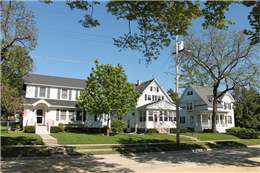How to Get a State or National Historic Designation for Your Building

Copeland Opera House, 1882
Shullsburg, Wisconsin. The Copeland Opera House was listed on the National Register in 1990 as a contributing building to the Water Street Commercial Historic District. Source: Photographer Mark Fay. View the property record: AHI 56601
You can acquire certain property benefits for your old house or building by getting an official state or national historic designation. These historic designations include the following two listings:
- National Register of Historic Places. The National Register of Historic Places serves as a means of honoring and recognizing important historic and cultural properties throughout the United States. The National Register is administered by the National Park Service. Listing on the National Register provides a degree of protection from federally funded or licensed activities, which must take into consideration an activity’s impact on historic resources. Income-producing properties listed on the National Register may also take advantage of federal rehabilitation tax credits. In Wisconsin, residential properties listed on the National Register also qualify for state tax credits. National Register status does not place restrictions on private property owners.
- State Register of Historic Places. The State Register of Historic Places is Wisconsin's official listing of state properties that are determined to be significant to Wisconsin's heritage. Most property owners who seek a historic designation apply for a listing on both registers, so properties listed on the Wisconsin Register are generally the same as those listed on the National Register.
Properties that have exceptional national significance may also be listed as a National Historic Landmark. These are places that have history that is relevant to all Americans. Fewer than 2,500 sites have been recognized with this distinction, compared with about 80,000 listings on the National Register.
Determine if Your Property Already has a Historic Designation

Frederick Wilhelm and Frances Amelia Winkenwerder House, 1870
Watertown, Wisconsin. This Federal style house is a part of the Richards Hill Residential Historic District and is listed on the National Register of Historic Places. This property is an example of a historic home that qualifies for tax credits. View the property record: AHI 7217
Before you undertake the process of getting a historic designation for your property, be sure to find out if it already has a historic designation. Many of Wisconsin’s older neighborhoods, downtown commercial areas and public and industrial buildings are already listed on the National Register of Historic Places. You can find out if your property is listed on the National and State Registers, either individually or as part of a historic district, by contacting the Wisconsin Historical Society. The Society serves as the State Historic Preservation Officer (SHPO) and has data on all Wisconsin properties that are listed on the National Register or potentially eligible for listing. The State Register is also maintained by the SHPO.
You can also go directly to the National Register website. It is organized for state and county searches, which allows you to find individually listed properties and historic districts.
Check the Criteria for Historic Designation

Aldo Leopold Shack, 1935
Fairfield, Wisconsin. The Aldo Leopold Shack was listed on the National Register in 1978. Source: WHS - State Historic Preservation Office. View the property record: AHI 16662
Both the National and State Registers include sites, buildings, structures, objects and districts that are significant to national, state or local history, architecture, archaeology, engineering and culture. For a property to be eligible for listing on the National and State Registers, it must satisfy one of the criteria of the National Park Service. Generally, a house or building must be at least 50 years old to be designated historic. The National Park Service chose this age requirement because 50 years is a time frame that allows for the proper perspective to assess a structure’s architectural and historical significance. Additional requirements must also be met.
Nominate Your Property to the National Register
A property is usually nominated to the National Register by a property owner, volunteer or consultant. If you decide to prepare a nomination for your property, your nomination must meet the requirements set forth in “National Register Bulletin 16: How to Complete the National Register Registration Form.” Your nomination will be reviewed by the staff of the Wisconsin Historical Society and then presented to the State’s Review Board for consideration.
If your property is approved at the state level, your nomination will be sent to Washington D.C. for federal review. If your property is approved at the federal level, it will be officially listed on the National Register of Historic Places.
Hire a National Register Consultant
If you would like to have your historic property listed on the National Register of Historic Places, you may want to hire a National Register consultant. A consultant can help you determine whether your property has a chance of being approved. National Register consultants know all the nuances involved in preparing these fairly complicated nominations. The National Park Service has minimum recommended qualifications for preservation consultants; however, consultants are not required to meet these requirements to work on historic properties.
To find a preservation consultant, seek a referral from other property owners or contact the Wisconsin Historical Society. The Society maintains a list of consultants who meet the minimum National Park Service requirements. It is important to take the time to evaluate each consultant you are considering by doing the following:
- Ask each consultant how many of the nominations he or she has prepared were successfully added to the National Register of Historic Places.
- Ask each consultant to show you other nominations he or she has prepared.
- Ask each consultant to provide references and talk to previous clients. Ask these previous clients about their experience with the consultant. Find out of the consultant was timely with his or her report and charged reasonable fees.
Seek Historic Tax Credits

Richards Hill Historic District
Watertown, Wisconsin. The Richards Hill Historic District was listed on the National Register in 2013. Source: WHS - State Historic Preservation Office - National Register.
To qualify for historic tax credits, your property must be listed on the National Register, either individually or as part of a National Register historic district. Most National Register consultants can also help you apply for state and federal historic tax credits.
